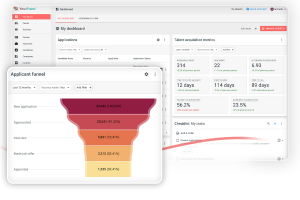HR and recruitment teams face growing pressure in today’s competitive hiring environment, where poor hiring decisions can impact every corner of an organisation. From rising turnover to under-resourced teams, the challenges are real—and often trace back to inefficient recruitment processes. With talent shortages increasing and the average time to fill a vacancy in Europe reaching 51 days, the demand for a smarter, data-driven approach to HR and recruitment has never been more urgent.
Why Metrics are Essential for HR and Recruitment
Recruitment metrics give you clear visibility into your hiring process, helping you track what’s working, what’s not, and where improvements are needed. These actionable insights allow organisations to measure effectiveness and make informed decisions across every stage of recruitment. To gain this deeper insight, organisations track a variety of key recruitment metrics. These include:
1. Total Applications
This metric reflects the initial interest generated by a vacancy, providing insight into the reach and effectiveness of your sourcing strategies. A high number of applications indicates strong visibility and interest in your job postings, helping gauge the success of your employer branding and outreach efforts.
2. Interview Count
This measures the quality and relevance of the candidates attracted through your recruitment activities. A high interview count often points to successful employer branding that draws in well-matched candidates. It also provides insight into how well your messaging resonates with potential hires.
3. Time to Close a Vacancy
This tracks the total time from requisition approval to the successful filling or closure of a position. It helps assess how efficiently your recruiting team manages vacancies and indicates how quickly your hiring process can adapt to meet business needs.
4. Time to Hire
This metric captures the time it takes from a candidate entering the recruitment pipeline (application stage) to accepting a job offer. It’s a key indicator of the efficiency of your hiring process and the candidate experience, highlighting areas where you may need to streamline or improve to keep top talent engaged.
5. Time to Fill
This tracks the time from the job requisition being opened to when the candidate accepts the offer. It’s an important metric for workforce planning, as it directly impacts the speed at which you can fill critical positions. A shorter time to fill can help minimise gaps in staffing and ensure operational continuity.
6. Vacancy Success Rate
This is the percentage of open roles that are successfully filled. It provides a clear indicator of the overall effectiveness of your recruitment function, revealing how well your strategies meet hiring demands and how efficiently your team is able to fill positions.
7. Average Applications per Successful Hire
This measures how many candidates, on average, apply before one is hired. It helps assess the efficiency of your sourcing channels and the quality of applicants they attract. A high ratio may point to poor targeting or overly broad job advertising, while a low ratio can suggest strong alignment between your sourcing strategy and role requirements.
Metrics like time to fill and time to hire offer valuable insights into both the efficiency of the recruitment process and the strength of an organisation’s talent attraction efforts. Time to fill can highlight potential gaps in sourcing strategies or bottlenecks in internal workflows, while time to hire reflects the candidate’s experience and can point to delays in screening, interviewing, or decision-making. With a global median time to hire of 38 days, benchmarking your organisation’s performance against industry standards can uncover opportunities to streamline processes and enhance competitiveness.
In addition, metrics such as time to close a vacancy and the average number of applications per successful hire provide HR and recruitment teams with deeper context for evaluating processes’ effectiveness. These figures can shed light on the reach and precision of sourcing channels, help identify quality-of-hire trends, and support more accurate workforce planning. By analysing them together, HR leaders can pinpoint what’s working, where friction exists, and how to make strategic improvements across the hiring funnel.
How Recruitment Dashboards Improve Hiring Outcomes
Why do many HR professionals hesitate to use recruitment metrics? Often, it’s because collecting and analysing data manually is time-consuming, laborious and prone to error. This traditional approach not only slows teams down but can also produce unreliable results. This is where automation makes a meaningful difference.
Recruitment dashboards offer a visual interface that consolidates key metrics, performance indicators, benchmarks, and goals. These dashboards provide a clear, digestible view of candidate attraction efforts, highlighting trends and pinpointing areas for improvement. Their real value lies in transforming fragmented data into actionable insights. By centralising information from multiple sources and presenting it through intuitive visuals, dashboards take care of the heavy lifting, eliminating the need for spreadsheets and hours of manual analysis.
As HR becomes more data-driven, automated dashboards integrated within Applicant Tracking Systems (ATS) have become essential tools. They streamline the process from data collection to real-time visualisation, providing consistent, reliable insights for faster, more informed decisions. Automation allows HR professionals to save time, ensure data accuracy, and focus on strategic improvements. It helps quickly pinpoint issues, optimise sourcing efforts and improve hiring outcomes by securing the right talent.
Leveraging Dashboard Insights to Drive HR and Recruitment Strategies
Integrated dashboards provide organisations with a comprehensive view of each stage in the hiring process, offering detailed insights into applicant progression, tracking drop-offs, and monitoring conversion rates from application to hire. With most modern recruitment systems now incorporating application funnels that can visualise the entire recruitment journey, dashboards uncover inefficiencies and patterns that may otherwise go unnoticed, empowering data-driven decisions to improve both speed and quality of hire.
Top candidates are exiting the job market in as little as 10 days, while the average time to hire stands at 38 days and time to fill at 51 days. Balancing the need for speed with the demand for quality is precisely where recruitment metrics and dashboards prove essential. Dashboards give HR and recruitment teams the visibility needed to identify obstacles that slow down the process, while also tracking key indicators related to candidate quality and offer effectiveness. With these insights, recruitment leaders can optimise workflows, accelerate hiring and maintain the standards necessary to build high-performing teams.
As the global talent race intensifies and the margin for recruitment error narrows, organisations must move beyond intuition-based hiring. Success in today’s market depends not just on effort, but on insight. Recruitment dashboards and metrics offer the strategic clarity required to navigate complexity, align teams, and act with purpose. For companies serious about competing for top talent, embracing data is no longer optional. It is fundamental to building a future-ready workforce. Those investing in smarter, more agile recruitment practices today are positioning themselves to lead tomorrow’s talent landscape.







